Rasmussen et al., 2018
Beyond clay: towards an improved set of variables for predicting soil organic matter content
Rasmussen C., Heckman K., Wieder W.R., Keiluweit M., Lawrence C.R., Berhe A.A., Blankinship J.C., Crow S.E., Druhan J.L., Hicks Pries C.E., Marin-Spiotta E., Plante A.F., Schädel C., Schimel J.P., Sierra C.A., Thompson A., Wagai R. (2018)
Biogeochemistry 137(3): 297–306 Cross-CZO
-
Catalina-Jemez, INVESTIGATOR
-
Sierra, INVESTIGATOR
-
Sierra, COLLABORATOR
-
Eel, INVESTIGATOR, COLLABORATOR
-
Christina, Luquillo, INVESTIGATOR, COLLABORATOR
-
Calhoun, Luquillo, INVESTIGATOR, COLLABORATOR
Abstract
Heat maps indicating the Spearman correlation between the conditional residuals of a mixed regression model using pedon ID as a random factor and horizon depth as a fixed effect, and soil physicochemical properties and climate parameters by the categorical variables of a humidity class, b ecoregion, and c soil order. Spearman correlations are scaled from dark blue for negative correlations to dark red for positive correlations. Those correlations with P > 0.0002 are considered not significant (NS), based on Bonferroni’s corrected α value
Improved quantification of the factors controlling soil organic matter (SOM) stabilization at continental to global scales is needed to inform projections of the largest actively cycling terrestrial carbon pool on Earth, and its response to environmental change. Biogeochemical models rely almost exclusively on clay content to modify rates of SOM turnover and fluxes of climate-active CO2 to the atmosphere. Emerging conceptual understanding, however, suggests other soil physicochemical properties may predict SOM stabilization better than clay content. We addressed this discrepancy by synthesizing data from over 5,500 soil profiles spanning continental scale environmental gradients. Here, we demonstrate that other physicochemical parameters are much stronger predictors of SOM content, with clay content having relatively little explanatory power. We show that exchangeable calcium strongly predicted SOM content in water-limited, alkaline soils, whereas with increasing moisture availability and acidity, iron- and aluminum-oxyhydroxides emerged as better predictors, demonstrating that the relative importance of SOM stabilization mechanisms scales with climate and acidity. These results highlight the urgent need to modify biogeochemical models to better reflect the role of soil physicochemical properties in SOM cycling.
Citation
Rasmussen C., Heckman K., Wieder W.R., Keiluweit M., Lawrence C.R., Berhe A.A., Blankinship J.C., Crow S.E., Druhan J.L., Hicks Pries C.E., Marin-Spiotta E., Plante A.F., Schädel C., Schimel J.P., Sierra C.A., Thompson A., Wagai R. (2018): Beyond clay: towards an improved set of variables for predicting soil organic matter content. Biogeochemistry 137(3): 297–306. DOI: 10.1007/s10533-018-0424-3
 This Paper/Book acknowledges NSF CZO grant support.
This Paper/Book acknowledges NSF CZO grant support.
Explore Further







